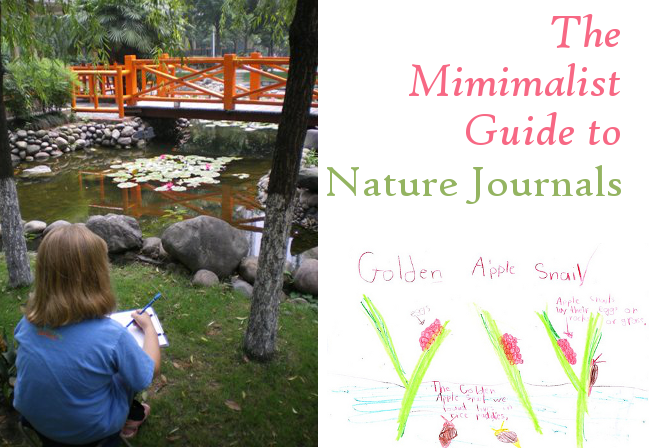The Minimalist Guide to Nature Journals
Nature study and nature journals are a very simple and energizing element within a homeschool routine that uses nature journaling. The foundation is direct observation – getting outdoors and experiencing nature with all of the senses. The idea is to look carefully, trusting what you see instead of relying on second-hand sources. As wonderful as nature stories are, they are not a substitute for personal experience, so you have to be deliberate about getting outside every week.
*This post contains affiliate links.
A nature journal is a useful complement to your nature explorations. Nature notebooking reinforces the outdoor lessons and brings the scientific method into your studies. After all, real scientists keep detailed records of their observations and experiments.
There is no reason to feel stressed about what to include in a nature journal. It can be a very flexible portfolio made up of a combination of these five things. For an ultra-minimalist approach, start with the first two. Then as your nature study develops, include the other three options in your nature notebooks.
1. Drawings
Drawing what you see in nature has two benefits. First, it slows you down enough to truly see. You can’t sketch something that you have not studied intently. Secondly, drawing provides a record of your nature excursion. Later, you can revisit your notebooking page to refresh your memory or compare to later experiences.
Besides pencil sketches, you can try your hand at crayon rubbings (of leaves or bark, for example) or watercolor paintings. A budding photographer may choose to take pictures and include those in his nature journal.
Depending on your preference and situation, these drawings can be done onsite or back at home. Be sure to carry a clipboard to provide a firm drawing surface and to keep papers from flying in the breeze. Or collect treasures to bring home for quiet sketching indoors.
2. Notes
Besides drawings, a nature journal is a great place for writing about what you saw. Here are some writing prompts for a nature journal:
- What did you see? (Also hear, feel, and smell?)
- What did you wonder about?
- What surprised you?
- What was the most beautiful thing you saw?
- How did you see the Creator?
You can use themed notebooking pages or blank paper to document your ideas. Again, these notes can be made onsite during the nature excursion or soon after a return home. Don’t allow for more than a day to elapse without making a written record because the vivid sensations of the nature experience will be dulled through forgetfulness.
3. Research
Most homeschoolers are naturally curious, and a nature walk can raise dozens of questions about the wildlife and natural forces being observed. This is why field guides and living science books are recommended for the homeschool library. Your nature study will prod you to identify the names of creatures and plants as well as a few basic facts about them.
Some families like to take field guides along on a nature walk; others prefer to do the research back at home with the help of the Internet. Either way, the facts you uncover can be written down in your nature journal.
4. Record Keeping
Another valuable part of a nature journal is keeping records of your observations tree in a more formal way such as through charts or logs. These records are not one-time assignments but ongoing projects that may last an entire year and provide an awareness of the cycles of nature.
- photograph and write about a tree all year long at predetermined points –maybe four times a year or each month
- seasonal milestones –such as the first daffodil bloom, first snow, or first day of summer that reached 100 degrees
- temperature and weather patterns – recording the amount of rainfall, daily temperatures, or cloud formations based on reading your own gauges and observing the sky.
Free seasonal chart templates can be downloaded from Jimmie’s Collage. Use them as-is or create your own logs based on the ideas there.
5. Cross-curricular connections
Your nature notebooks can also hold a crossover of academic disciplines. You may study nature in art or music inspired by nature or poems about nature. Obviously, science will often feature in your nature journal as you follow your children’s interests to explore geology, botany, entomology, and so on. There may even be historical topics that connect to your nature studies. You can write about any of these in a nature journal.
Those five elements give you some starting points for keeping a nature journal. Every nature walk will be different, and every journal entry will vary accordingly. The key is to allow the experience outdoors to be the launching pad for your drawings, words, research, and record keeping.
To learn more about notebooking for nature and other subjects, visit The Notebooking Fairy and read Notebooking Success, a complete guide to using notebooking in your homeschool. To help you plan this year’s nature studies please download these nature planning pages specially designed for your homeschool mom notebook.
************************************

Jimmie Lanley is the mother of one creative daughter. Living abroad in China necessitated the original choice to homeschool. Jimmie’s Collage is where she blogs about her Charlotte Mason-styled homeschool. In the early years, Jimmie’s lesson plans were full of hands-on activities and lap books. As the years passed, she began using more and more notebooking and became so passionate about the method that she created her second blog, The Notebooking Fairy. That site features free notebooking printables and how-tos plus the affordable eBook guide Notebooking Success.
This post was part of our Nature Week here at The Homeschool Scientist! Read the other blog posts HERE.



